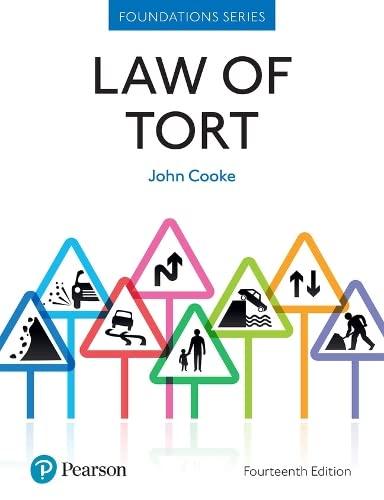Question
Respond to the following scenario: Travis Austin was the sole shareholder and manager of Remember the Alamo, Inc., an Scorporation that operated a popular nightclub
Respond to the following scenario:
Travis Austin was the sole shareholder and manager of Remember the Alamo, Inc., an Scorporation that operated a popular nightclub of the same name in San Antonio, Texas. Austin maintained a corporate checking account but paid the club's employees, suppliers, and entertainers in cash out of the club's proceeds. Austin, in his individual capacity, owned the property on which the club was located. He rented it to the club but made mortgage payments out of the club's proceeds and often paid other personal expenses with corporate funds. At 12:45 A.M. on July 31, eighteen-year-old Lady Bird Johnson, who was already intoxicated, entered the nightclub at 11:00 p.m. A city ordinance prohibited individuals under the age of twenty-one from entering premises that served alcohol unless accompanied by their parents, but the bouncer failed to check Johnson's identification and verify her age. She drank more alcohol at the nightclub
and was visibly intoxicated when she left around 3:00 A.M. After she had driven only a few blocks, Johnson lost control of her car, struck a tree, and was killed. Subsequently, her parents Joseph filed a lawsuit in a Texas state court against Remember the Alamo, Inc., and Travis Austin, seeking damages.
1. Under what theory might the court in this case make an exception to the limited liability
of shareholders and hold Austin personally liable for the damages? What factors would
be relevant to the court's decision?
2. Suppose that Remember the Alamos's articles of incorporation failed to describe the
corporation's purpose or management structure as required by state law. Would the court
be likely to rule the Auston is personally liable on that basis?
3. Suppose that the club extended credit to its regular patrons in an effort to maintain a loyal clientele, although neither the articles of incorporation nor the corporate bylaws
authorized this practice. Would the corporation likely have the power to engage in this
activity? Explain.
4. How would the court classify the corporation: domestic or foreign, public or private?
Step by Step Solution
There are 3 Steps involved in it
Step: 1

Get Instant Access to Expert-Tailored Solutions
See step-by-step solutions with expert insights and AI powered tools for academic success
Step: 2

Step: 3

Ace Your Homework with AI
Get the answers you need in no time with our AI-driven, step-by-step assistance
Get Started


